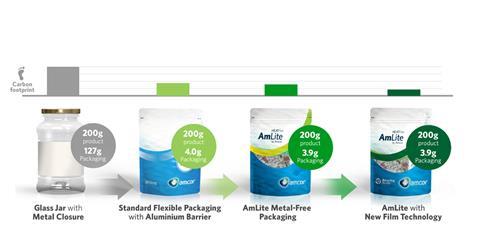
Amcor has set out to transform the circular capability of flexible packaging with the launch of a new polyolefin barrier film – a platform technology for packaging a huge variety of products. The culmination of several years’ R&D and a major step toward achieving Amcor’s pledge to develop all its packaging to be recyclable or reusable by 2025, this innovation appears to have reached the El Dorado of flexibles: a polyolefin-based substrate that can be used for ambient and retort high-barrier applications – and can be recycled. Amcor spoke exclusively about the launch with Packaging Europe’s Tim Sykes.
Today, many products are protected by high barrier packaging that is not easily recyclable due to their multi-material structures. A good example is retort pouches, which today use polyester, aluminium and polyolefins as base materials to achieve protection and deliver high-barrier performance. Due to different melting points, polyolefins, PET barrier films and aluminium cannot be recycled together, and their recycling requires pure feedstocks. Evidently, a purely polyolefin alternative that would be recyclable through existing waste streams would be a game changer. But could industry find an alternative that matches the barrier and heat resistant performance of multi-material laminates?
Amcor’s answer to this question is: yes, it can.
“Our breakthrough innovation is a high-barrier OPP film with SiOx (silicon oxide) coating that has met the challenges of delivering outstanding performance for barriers, sealing, and withstanding high heat processing, such as retort and heat sterilisation,” Luca Zerbini (VP of sustainability, marketing and innovation for Amcor’s Flexibles business in EMEA) revealed to Packaging Europe. “This new polyolefin film will be a building block to develop flexible packaging for a huge variety of products, from ready-meals to wet pet food, coffee to nuts and snacks.”

At a time when many players on the flexibles market are investing in monopolymer innovation, the importance of this development lies in its range of high-performance applications. Many of the solutions the industry has brought to market have been medium- to low-barrier solutions, unsuited to retort applications, or often developed as bespoke solutions for particular applications. Amcor has taken a different approach, by working on a platform that can be applied across a whole range of packaging contexts. The ambition is bold: nothing less than transforming the whole industry.
The new platform will be available in three basic grades: ambient medium barrier, ambient high barrier and retort high barrier. According to Amcor, the retortable grade is offering barrier performances of <1cc oxygen and <1g moisture after converting and retort (numbers which align with the top performing non-recyclable barrier films currently on the market, for instance PET barrier films). The figures for the ambient high-performance grade are below 0.1 cc oxygen and 0.1 g moisture.
“No other polyolefin film on the market approaches these properties,” commented Andrea Della Torre (senior R&D director, EMEA). “This film is a true breakthrough for high barrier and retort pouches, and is a huge step forward toward meeting our own, and our customers’ sustainability commitments.”

The circularity transformation
Making its 2025 pledge in January this year, Amcor became the first global plastic packaging company to commit to develop all of its packaging to be recyclable or reusable – and the launch of the new family of recycling-ready polyolefin films should be read as the first milestone in realising that goal. However, the story of Amcor’s strategic readjustment and R&D groundwork stretches back much further.
“Historically, flexible packaging emphasised its ability to protect the product with utmost efficiency and reduced carbon footprint,” Mr Della Torre told Packaging Europe. “We tended to see sustainability through the prism of LCA, but already some time ago we recognised that waste management was an Achilles’ heel for composite materials. Today I think it’s fair to say that providing viable solutions for end-of-life is a prerequisite, a basic licence to operate. Today, dedicated R&D teams are working on the challenge, codified more recently in the pledge, of converting the entire product portfolio to be recycling-ready with existing and emerging recycling infrastructure.”

The journey to this destination has been long and tortuous. “Before applying material science we do thorough analysis of shelf-life requirements in partnership with our customers,” Mr Della Torre continued. “Applying these insights, we first worked on eliminating aluminium and then PET from barrier films. Concentrated R&D on surface coating for polyolefin films, using Amcor’s SiOx vacuum facility (the only one of its kind in Europe), has taken place over the last three and a half years.”
Now Amcor is in a position to start rolling out the achievements of its long-term platform research across multiple market segments. The full market launch will be underpinned by investment in a second SiOx facility to support the necessary volumes. For the moment, however, the new film is undergoing a series of tests at the customer level.
“We are currently running trials of the new film with several customers who have made pledges similar to Amcor’s own regarding recyclability of packaging and the initial feedback is extremely positive,” Mr Zerbini reported. “In fact, this is going to defy a lot of expectations across the market. When we made our recyclability pledge there were some who interpreted it to mean that Amcor was vacating the retort market.”

Sustained commitment
If the public 2025 pledge acted to accelerate existing efforts to move towards recyclable packaging, it also sets the agenda for future innovation. “We have an exciting opportunity to drive the industry forward,” remarked Mr Zerbini. “This is just the first solution we are launching in the process of meeting the commitments of our pledge. There will be further announcements: more key projects in the pipeline to convert the remaining areas of the Amcor product range to recycling-ready.”
As everyone knows, the recyclable packaging innovation challenge only satisfies part one of the overall societal problem. “We’re aware that ‘designed for recycling’ is only the first stage and means nothing if the packaging isn’t collected and recycled,” said Dr Gerald Rebitzer (sustainability director, Amcor Flexibles). “Many recycling systems don’t accept flexible packaging today. This is an area where engagement with industry, policy makers and cross-value chain organisations is critical.”

Standardisation will be essential in effecting the required investments and creating demand for recyclate – which is why forthcoming guidelines from organisations such as the Ellen MacArthur Foundation and CEFLEX have such an important role to play. These align raw material suppliers, converters, brand owners, retailers, sorting and recycling facilities and regulators on how to realise a circular economy for flexibles. The recycling blueprint, encouraging polyethylene and polypropylene while proscribing PET and PVC, illuminates the business sense behind Amcor’s resource-heavy R&D program.
“The new film has the potential to generate financial as well as environmental savings,” commented Mr Zerbini. “In markets where our customers pay Extended Producer Responsibility fees, Amcor’s new development will offer the potential to reduce these fees, especially with upcoming regulations where fees are modulated based on recyclability.”
Another repercussion of any breakthrough in struggle against unrecycled plastic waste is that it works against complacent distraction from an arguably greater threat.
“Building a circular economy is a demand that we fully accept but we also need to look at sustainability holistically,” concluded Dr Rebitzer. “We mustn’t lose sight of the fact that climate change is the number one challenge. Implementation of the Paris Agreement is slow. We know that if food waste were a country, it would be the third largest CO2 emitter in the world. In parallel with our ongoing activities to make all our packaging recyclable, we continue to work on downgauging and developing packaging that reduces food waste and other damage and loss. And in bringing to market high-performance films that can meet the demand for zero waste, we enable flexible packaging to continue to deliver the resource efficiency a growing global population desperately needs.”










